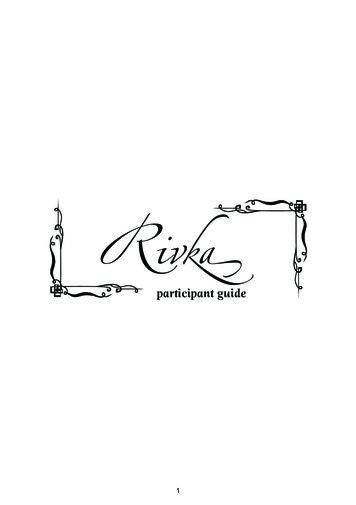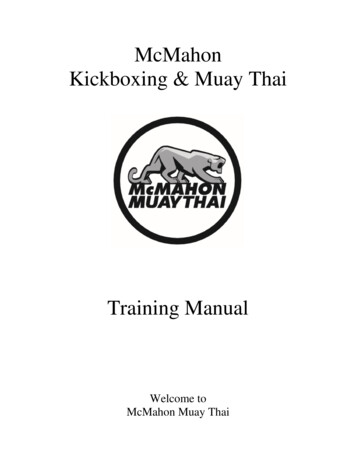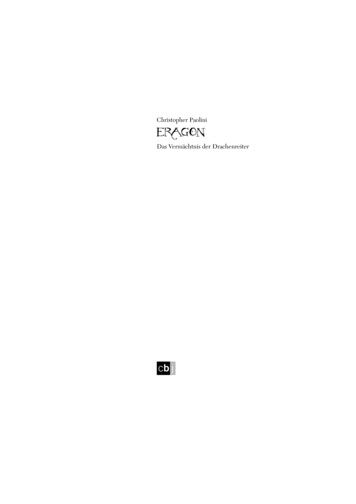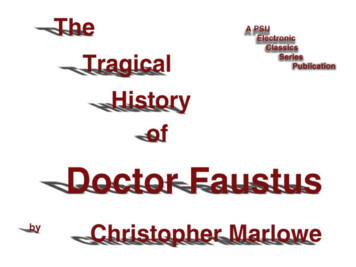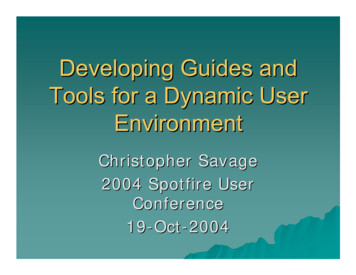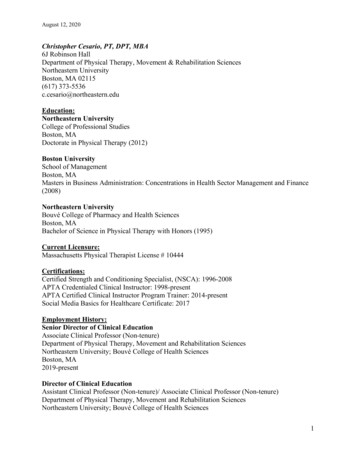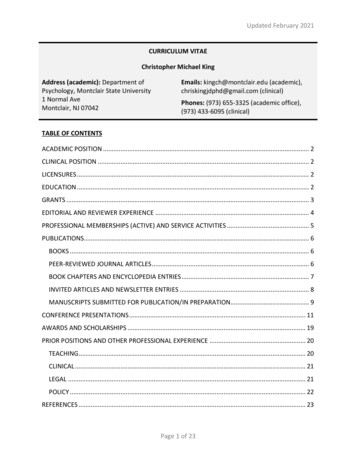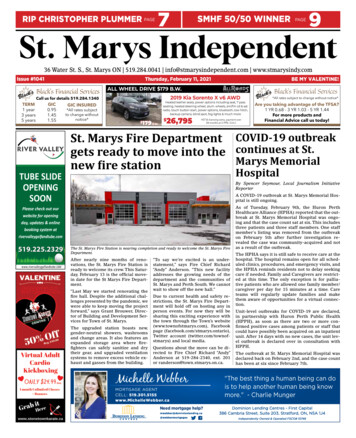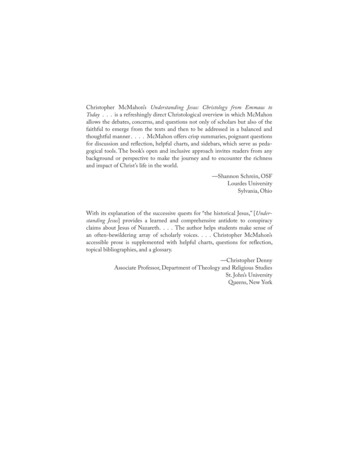
Transcription
Christopher McMahon’s Understanding Jesus: Christology from Emmaus toToday . . . is a refreshingly direct Christological overview in which McMahonallows the debates, concerns, and questions not only of scholars but also of thefaithful to emerge from the texts and then to be addressed in a balanced andthoughtful manner . . . . McMahon offers crisp summaries, poignant questionsfor discussion and reflection, helpful charts, and sidebars, which serve as pedagogical tools. The book’s open and inclusive approach invites readers from anybackground or perspective to make the journey and to encounter the richnessand impact of Christ’s life in the world.—Shannon Schrein, OSFLourdes UniversitySylvania, OhioWith its explanation of the successive quests for “the historical Jesus,” [Understanding Jesus] provides a learned and comprehensive antidote to conspiracyclaims about Jesus of Nazareth. . . . The author helps students make sense ofan often-bewildering array of scholarly voices. . . . Christopher McMahon’saccessible prose is supplemented with helpful charts, questions for reflection,topical bibliographies, and a glossary.—Christopher DennyAssociate Professor, Department of Theology and Religious StudiesSt. John’s UniversityQueens, New York7047-Understanding Jesus CS6.indd 18/16/13 11:40 AM
Author AcknowledgmentsAt the outset, I would like to express my gratitude to those people in my lifewho have boldly modeled their faith in Christ and challenged me to be a morefaithful and consistent disciple. My families, students, and so many friends,especially Julie Pomerleau, to whom this small book is dedicated, have powerfully illuminated my world with their dynamic witness to the central conviction of the Christian community: “In Christ God was reconciling the world tohimself, not counting their trespasses against them” (2 Corinthians 5:19). Without such witness, the Christological doctrines and the theological tradition thatseeks to make sense of those doctrines will at best remain mere curiosities andwill leave Jesus as a historical figure standing on the shores of an ancient anddistant landscape.I would like to thank the publishing team at Anselm Academic, especiallyJerry Ruff, Paul Peterson, Brad Harmon, and Maura Thompson Hagarty, aswell as the anonymous readers and instructors who have given feedback over theyears. They have helped to revise this text (originally titled Jesus Our Salvation)and have made it a more effective teaching tool. Among those who gave helpful feedback in the formation of the first edition were Terrence Tilley, RalphDel Colle, Mary Ann Baran, SND, and Shannon Schrein, OSF. My colleaguesat Saint Vincent College have provided me with feedback along the way andguided me to many useful sources. Rene Kollar, OSB, the Dean of the School ofHumanities and Fine Arts, Jason King, the chair of the Department of Theology,and my colleague, Patricia Sharbaugh, have provided constant encouragement,friendship, and support, as have Nathan Munsch, OSB, Campion Gavaler, OSB,Tom Hart, OSB, and Elliott Maloney, OSB.Scottdale Mennonite Church, my wife’s church community and mine bymarriage and fellowship, afforded me the opportunity to teach an adult Sundayschool class and to preach during the long months of revising this book, and theyprovided valuable feedback on my presentation of the material. As a non-creedalchurch, they helped me to articulate more precisely the value and limitationsof the dogmatic tradition. The blessing of sharing in two church communities,one Catholic and the other Mennonite, has challenged me and left me doublyblessed over the years.Finally, no one has imaged Christ in my life more consistently or nobly thatmy wife, Debra Faszer-McMahon. Her patient endurance and steadfast love aswell as her skill as a teacher and writer have improved every aspect of this bookin both its first and second editions. Words cannot express the debt I owe her.As always, the efforts of those mentioned here do not diminish my responsibilityfor this text, and any errors or oversights are my own.7047-Understanding Jesus CS6.indd 28/16/13 11:40 AM
Understanding JesusCHRISTOLOGY FROM EMMAUS TO TODAYCHR IST OPHER MCMAHON7047-Understanding Jesus CS6.indd 38/16/13 11:40 AM
Created by the publishing team of Anselm Academic.Cover image royalty-free from iStock.com.The scriptural quotations contained herein are from the New Revised Standard Versionof the Bible, Catholic Edition. 1993 and 1989 by the Division of Christian Educationof the National Council of the Churches of Christ in the United States of America. Allrights reserved.Vatican documents and translations are taken from vatican.va unless otherwise noted.Quotations from the Catechism of the Catholic Church are taken from English translationof the Catechism of the Catholic Church for the United States of America copyright1994 and 1997 United States Catholic Conference, Inc.—Libreria Editrice Vaticana,available at usccb.org/catechism/text/.Copyright 2007, 2013 by Christopher McMahon. All rights reserved. No part of thisbook may be reproduced by any means without the written permission of the publisher,Anselm Academic, Christian Brothers Publications, 702 Terrace Heights, Winona, MN55987-1320, www.anselmacademic.org.Printed in the United States of America7047ISBN 978-1-59982-426-0, Print7047-Understanding Jesus CS6.indd 48/16/13 11:40 AM
To Julie,in gratitude for your friendship and humble witness to Christ’s saving love(Romans 5:5; Galatians 2:19b–20)7047-Understanding Jesus CS6.indd 58/16/13 11:40 AM
7047-Understanding Jesus CS6.indd 68/16/13 11:40 AM
ContentsPreface to the Revised Edition / 111. Contemporary Christology and the Historical Jesus . . . . . . . . . . 13Changing Paradigms and Shifting Terrain / 14The Old Quest: The Challenge of the Enlightenment / 16Beyond the Question of the Historical Jesus / 22The Quest Gets Baptized / 25The Problem of History: Understanding the Limits and Valueof History / 29Conclusion / 312.A Tentative Historical Portrait of Jesus . . . . . . . . . . . . . . . . . . . . . . . . . . . . 34Historical Jesus and the Criteria of Historicity / 34Applying the Criteria: A Tentative Sketch of the Historical Jesus / 42Conclusion / 693. The Resurrection. . . . . . . . . . . . . . . . . . . . . . . . . . . . . . . . . . . . . . . . . . . . . . . . . . . . . . . . . . . . . 72The Old Testament Period / 72The Afterlife in the Intertestamental Period / 80The New Testament Period / 84The Contemporary Debate / 89Conclusion / 934. New Testament Christologies. . . . . . . . . . . . . . . . . . . . . . . . . . . . . . . . . . . . . . . . . . 96The Background for New Testament Christology:“The One Who Is to Come” / 97The Growth of New Testament Christology: Titles, Roles,and Patterns / 102Christology in Paul / 108Christology in the Synoptic Gospels / 112Wisdom and Logos: The Confluence of Jewish and Greek Ideas / 119Conclusion / 1247047-Understanding Jesus CS6.indd 78/16/13 11:40 AM
5. The Development of Classical Christology. . . . . . . . . . . . . . . . . . . . . . 126The Way to Nicaea (100–325) / 127Political and Theological Conflict as Enginesfor Doctrinal Development: Constantinople I (381) / 134Political and Theological Conflict as Enginesfor Doctrinal Development: Ephesus (431) / 136Schism and Compromise: Between Ephesusand Chalcedon (433–448) / 139More Politics and More Doctrine:The Council of Chalcedon (451) / 140The Aftermath of Chalcedon (451–553) / 144Conclusion / 1466. The Work of Christ. . . . . . . . . . . . . . . . . . . . . . . . . . . . . . . . . . . . . . . . . . . . . . . . . . . . . . . . 148Biblical Images of Salvation / 148Soteriology through the Middle Ages / 153The Reformation and the Doctrineof Penal Substitution (1500–1600) / 161Conclusion / 1677. Christology and Social Transformation. . . . . . . . . . . . . . . . . . . . . . . . . . . . 169Sin, Conversion, and Society / 170Revolutionary Christology / 178Feminist Christology / 180Postcolonial Christology / 186Conclusion / 1908. Jesus and Other Religions. . . . . . . . . . . . . . . . . . . . . . . . . . . . . . . . . . . . . . . . . . . . . . 193Traditional Christian Response to Religious Pluralism / 194Christology and Pluralism at the Turn of the Century / 201The Return of a High-Descending Christology / 209Conclusion / 214Glossary / 217Index / 2357047-Understanding Jesus CS6.indd 88/16/13 11:40 AM
List of Charts and SidebarsChapter 1Person of Interest: Albert Schweitzer / 21The Historical Jesus at the Turn of the Last Century / 24Christianity and Existentialism / 28Modernism among Catholics and Protestants / 30Chapter 2Selectively Sketching Jesus / 35Four Sketches of the Historical Jesus / 35Stages and Sources in the Gospel Tradition / 36The Markan Hypothesis, the Two-Source Theory, and Q / 38Primary Criteria for Historical Jesus Research / 41Person of Interest: Josephus / 45Qumran and the Dead Sea Scrolls / 49Some Modern Approaches to New Testament Eschatology / 53Person of Interest: Apollonius of Tyana / 57Major Sects in First-Century Palestinian Judaism / 60The Battle to Understand Judaism in the New Testament / 63Chapter 3The Afterlife in History and Tradition / 74The Canon, the Apocrypha, and the Deuterocanonicals / 77Person of Interest: Philo / 81Some Messianic Figures in Judaism / 83The Variant Accounts of Jesus’ Resurrection in the Gospels / 87Person of Interest: N. T. Wright / 92Chapter 4Does the New Testament Call Jesus “God”? / 98Some Titles, Roles, and Patterns in New Testament Christology / 104Person of Interest: Paul / 109Kenōsis and Buddhism / 111The Parting of the Ways: Christianity and Judaism / 115Gospel Christologies: Portraits for Particular Audiences / 116Person of Interest: Origen / 122Chapter 5Caesar and the Church / 130Alexandria and Antioch / 135The First Four Ecumenical Councils: A Time Line / 143Person of Interest: Theodore of Mopsuestia / 1457047-Understanding Jesus CS6.indd 98/16/13 11:40 AM
Chapter 6Sacrifice in Ancient Israel / 151Person of Interest: Peter Abelard / 159René Girard’s Theory of Sacrifice / 161Soteriologies: A Simplified Comparative Chart / 164Chapter 7Person of Interest: Søren Kierkegaard / 170Lonergan and the Notion of Bias / 173Marxism, Liberation Theologies, and the Catholic Church / 179Some Other Forms of Contemporary Feminist Theologies / 185Cosmic and Metacosmic Religiousness / 189Chapter 8Religion, Tolerance, and Armed Conflict: Islam and Christianity / 196Christian Perspectives on Religious Pluralism / 200The Incarnation of God in Hinduism: The Avatars of Vishnu / 203Pope John Paul II and The Relationship between Christians and Jews / 2077047-Understanding Jesus CS6.indd 108/16/13 11:40 AM
P r e fac e tothe Revised EditionThe motivation to offer a revised edition of a textbook can often appear simplyto be financial, a means of addressing economic issues on the side of the publishers or the author. Yet, at times, circumstances demand a book be revised, and Ihope that readers of this text will appreciate the many reasons for this revision ofJesus Our Salvation.First, the original edition was well received by instructors and students, earning the book praise and numerous course adoptions. Yet, the book was craftedin the early stages of Anselm Academic’s foray into the college textbook market,and the precise editorial voice of the press had yet to be established. Moreover, itwas my first book, and the combination of these two factors played a role in theshortcomings of the original edition. The opportunity to revise the text in lightof my experience and the insights of the experienced editorial team at Anselmcould not be ignored. It is my hope that the current edition will preserve the virtues of the first edition, correct any of its errors, and provide both instructors andstudents with an even more useful tool for engaging the questions surroundingthe religious significance of Jesus within the Christian tradition.Second, the original edition seemed to take an explicitly faith-centeredstance on Christology, and many readers thought that it presupposed (or evenimposed) a faith stance. Feedback from instructors indicated that this perception hampered the book’s usefulness in settings where a significant number ofstudents did not share the same faith traditions or convictions. The new edition seeks to remedy this problem by adopting a “faith friendly” perspective, onethat articulates basic Christian and often Catholic convictions on Christologywithout presupposing these convictions are shared by the reader. The title anddesign of the book have been changed along with the artwork and the questionsfor reflection so as to accommodate a wider audience. While no text will pleaseall readers, I believe that the current edition represents a strong and consistentattempt to address this important issue in a balanced way—in a way hospitableto readers representing a wide range of faith convictions.Third, in this revision I have added some new material and revised muchof the original. For example, although many readers appreciated the sidebar discussions, a few sidebars seemed either inordinately long or otherwise distracting. Several such sidebars have been deleted, and others have been revised and117047-Understanding Jesus CS6.indd 118/16/13 11:40 AM
12U nderstanding J esusabbreviated. Additionally, the presentation on the various quests for the historical Jesus in chapter 1 has been tightened and incorporated into a discussion ofthe paradigmatic shift in Christology that has taken place over the course ofthe past century. The reconstruction of Jesus’ life and ministry in chapter 3 hasbeen tightened, and the material on the resurrection of Jesus in chapter 3 hasbeen expanded slightly. The discussion of NT Christology in chapter 4 includesadditional material on the provenance and complexities associated with theterm messiah within late Second Temple Judaism. Additionally, the discussionof soteriology in chapters 6 and 7 has been improved with an expansion of theapproach offered by Aquinas and a fuller presentation of Rene Girard’s contribution to contemporary soteriology.This revised edition will, I hope, continue to serve college students with auseable, approachable, and engaging text that will help focus and direct furtherinquiry into the central claim of the Christian tradition, namely that in Christ,God is reconciling the world to himself. The book takes a theological ratherthan purely historical or social-scientific approach to Christology. I hope thatthis theological presentation resonates with both believers and nonbelievers in away that makes Christian claims about Christ a compelling and fruitful topic forinquiry and discussion.7047-Understanding Jesus CS6.indd 128/16/13 11:40 AM
chapter1Contemporary Christologyand the Historical JesusThe Western world, which for more than fifteen hundred years had defineditself in relation to the Christian tradition, is rapidly being redefined, largely by aglobalized and distinctly post-Christian culture. Today all religions, and Christianity in particular, struggle to promote the integration of a life of faith with dailyeconomic and political concerns. The broader culture tends to define the valuespeople hold, leaving religious values marginalized or blended and indistinct.Standing twenty centuries removed from the life of Jesus of Nazareth,Christians struggle to articulate the relevance of his life and the doctrinal statements about him that emerged in the intervening centuries. What remains isoften pious religious sentiment or technical theological study, as the claims aboutJesus made in the history of Christian theology fade into obscurity. Indeed, thehistory of theology is in some ways a history of forgetting. This is especiallytrue of the discipline known as “Christology,” i.e., critical reflection on the religious significance of Jesus. Many Christians regard the Christological traditionas irrelevant for contemporary faith, and many choose to ignore it or simply forget it. A number of theologians in the nineteenth and twentieth centuries haveeven attempted to drive out what they regarded as the “demons” of medieval andancient Christology and its creeds.Dissatisfaction with what might be called “creedal Christianity”1 and acultural move away from organized religion in the West has turned many contemporary Christians away from classic Christology to focus exclusively on theBible, hoping thus to arrive at a simpler, clearer understanding of Jesus. Such amaneuver has its own problems, however, for how do we know that the Gospelsgive us a true picture of Jesus? The desire to get behind the canonical Gospels to1. This phrase will become clearer in the course of this text; for now, it is sufficient to identify“creedal Christianity” with the classic formulations of Christian doctrine that emerged in the courseof the Christological controversies of the fourth and fifth centuries and resulted in the formulationof the Nicene and Chalcedonian statements of faith.137047-Understanding Jesus CS6.indd 138/16/13 11:40 AM
14U nderstanding J esusfind the real Jesus—the Jesus whom some claim has been hidden and distortedby the early Christian church—has led to a series of scholarly “quests” to discover who Jesus really was. On a more popular level, the suspicion that the realJesus was different from the Jesus of the Gospels has found expression in thewidely popular book and film The Da Vinci Code.Where does one turn, then, for answers? If the ancient creeds are irrelevant and if the Gospel accounts cannot be trusted—as both Jesus scholarsand a skeptical, secular culture seem to insist—what is an ordinary believer todo? One response has been to allow one’s devotional life to become privatizedand individualized—insulation, after all, can be comforting. As long as oneremains within one’s private devotional life or that of a small group of likeminded people, images or claims about Jesus can remain largely unexamined.Yet, the desire to bridge this gap between faith and understanding has focusedthe work of theologians in recent years, and these attempts define the landscapeof contemporary Christology.Changing Paradigms and Shifting TerrainIn the past, Christology was a rather straightforward theological discipline. Acourse on Christology had a mathematical precision to it—one investigated howGod became human in Christ, what powers Christ had, and how the death andresurrection of Christ saved humanity. As the reader can probably tell already,the account of Christology offered in these pages will not be so straightforward,for contemporary Christology in general is not straightforward. In fact, mosttheologians now would begin by discussing how modern times really shifted theterrain or the paradigm for doing Christology (and all theology).This paradigm shift in the way Christology is done and taught was championed by, among others, the great Roman Catholic theologian Karl Rahner(1904–1984). Rahner was particularly concerned with how modern Christianshad all but forgotten their own Christological teaching, which emphasized boththe full humanity and full divinity of Jesus.2 Although established at the Council of Chalcedon in 451, by Rahner’s day most Christians paid only lip serviceto this doctrine, which to the average lay person seemed essentially irrelevant.Rahner believed that the teaching of Chalcedon, and indeed all the classic formulations on Christ, represented both obstacle and opportunity for the renewalof Christology.The Council of Chalcedon had emphasized the full humanity of Christalong with his full divinity. Nevertheless, all of the early Christological proclamations, Chalcedon included, tended to enshrine a “high descending” approach2. Karl Rahner, “Current Problems in Christology,” Theological Investigations, vol. 1 (Baltimore:Helicon, 1961), 149–200.7047-Understanding Jesus CS6.indd 148/16/13 11:40 AM
Contemporary Christology and the Historical Jesus15to Christology. The prologue to John’s Gospel best illustrates this approach: theWord of God descends from heaven, becomes flesh, is glorified in death, andreturns to the Father in heaven. In Christian art, we often see images of theAnnunciation represented as a tiny person (often carrying a cross, as in RobertCampin’s Annunciation Triptych) who flies down from heaven and occupies thewomb of the Blessed Mother. Such an approach to Christology tends towarda crude literalism—which may have made perfect sense in the worldview ofancient peoples, but as Rahner argued, it has become perilously out of date andtheologically dangerous today.A high-descending approach has burdened many Christians with a warpedand unorthodox Christology that Rahner termed crypto-monophysitism. Thatis, he accused people of being closet “monophysites”; monophysites—from theGreek words monos (one) and physis (nature)—were early Christian heretics whobelieved that Jesus had only one (divine) nature. In effect, Rahner was saying thatmodern Christians, although verbally affirming the full humanity and full divinity of Christ, actually downplay or forget that Christ was also fully human. Thisneglect of Jesus’ humanity is entirely understandable given the high-descendingapproach that dominated Christological discourse and popular piety for centuries. Such an approach tended to produce a mythical understanding of Jesus thatdisconnects him from human experience and history alike—which is not at allwhat those who framed the creed of Chalcedon had in mind.Rahner argued for a shift in Christological thinking, away from the highdescending approach to an emphasis on Christ’s humanity—a low-ascendingapproach—as the path to recovery of authentic Christology. Some theologians,however, objected to this move, arguing that a low-ascending approach woulddiminish the divinity of Christ. Anticipating such an objection, Rahner asserted,“Anyone who takes seriously the historicity [authenticity] of human truth (inwhich God’s truth too has become incarnate in Revelation) must see that neitherthe abandonment of a [theological] formula nor its preservation in a petrifiedform does justice to human understanding.”3 Just because one states a doctrinecorrectly does not mean that one really believes it—i.e., one doesn’t necessarilyact according to one’s stated belief. The mere repetition of Christological doctrines and formulae does not mean that they have been properly understood oradequately appropriated.When talking about God, something more is always possible, Rahnerargued. Therefore, the shift to a low-ascending Christology is not really a challenge to traditional Christology; rather, it is the means by which contemporaryChristians do homage to the tradition and renew it.This book will follow a low-ascending approach. Such an approachwill inevitably raise issues that can prove both helpful and problematic for3. Ibid., 150.7047-Understanding Jesus CS6.indd 158/16/13 11:40 AM
16U nderstanding J esusarticulating a contemporary Christology that is faithful to the tradition. However, in the end, this approach also positions the discipline of Christology toaddress the questions and issues raised within the broader culture so that theChristological tradition may be better understood beyond the boundaries ofthe Christian church.Interest in a low-ascending Christology has been responsible, in part, forthe wave of books, films, and documentaries on Jesus we have seen over the pasttwo decades. Christians have found some of these images of Jesus disconcerting: Jesus as a violent revolutionary, a confused and naïve religious reformer, amagician, and a philosopher. The diverse depictions all purport to offer a view ofthe person behind the canonical Gospels, the historical human rather than thereligious figure proclaimed by the Christian church—which brings us back tothe question of “the real Jesus” behind the Gospel accounts. In scholarly terms,this is the question of “the historical Jesus”; the remainder of this chapter will bedevoted to it.The Old Quest: The Challenge of the EnlightenmentThe Enlightenment provides the basic backdrop against which the so-called oldor original quest for the historical Jesus is best understood. In the sixteenth andseventeenth centuries, “wars of religion,” sparked by the Reformation and theCatholic Counter-Reformation, had swept across Europe; allegedly Christianrulers busily tried to kill one another in the name of Jesus (the wars of religion were, in many ways, not about religion but about political power).4 Thesewars helped to discredit religion and religious authority in Europe. If Christianauthorities on either side of a conflict could cite divine sanction for their violentaggression, the logic behind their respective rationale had to be highly selectiveand self-serving, to say the least.The discrediting of religion and religious authority prompted many thinkersto look outside religion for answers to questions of reason, truth, and morality.The era of the Enlightenment, which followed, was characterized by a pervasivesuspicion of religious claims and religious authority. Instead, the Enlightenmentcelebrated the work of the individual mind that was free from irrational beliefsand unconstrained by religious authority. The Enlightenment set the stage forthe old quest for the historical Jesus that emerged in the nineteenth century bydiscrediting traditional Christianity and its scriptures.However, the Enlightenment’s hostility to organized religion provides onlyone piece of the background necessary for understanding the old quest. The4. For a provocative and insightful account of these conflicts, see William T. Cavanaugh, TheMyth of Religious Violence: Secular Ideology and the Roots of Modern Conflict (Oxford University Press,2011), 123–80.7047-Understanding Jesus CS6.indd 168/16/13 11:40 AM
Contemporary Christology and the Historical Jesus17other piece involves the Enlightenment’s successor, Romanticism. Whereas theEnlightenment emphasized the cool logic of scientific reason as the sole criterion of truth and value, Romanticism emphasized the emotional, mystical, andmore natural aspects of human existence. Like the Enlightenment, Romanticismprized individual experience and was suspicious of organized religion and religious authority. However, Romanticism was much more comfortable creativelyengaging traditional Christianity than was the Enlightenment, albeit in a subversive way. Together Romanticism and the Enlightenment, to varying degrees,fueled the major efforts of the old quest.Looking for Jesus amid Social and Cultural RevolutionThe French Revolution (1789) was a watershed in the political, social, andreligious life of Europe. The insights and challenges posed by Enlightenmentthinkers came to fruition in the French Revolution, with its wholesale rejection of the old order of Europe, including the cultural and political influence ofthe Christianity. At this time the father of historical Jesus research, HermannSamuel Reimarus (1694–1768), inaugurated what has come to be known as theold quest for the historical Jesus.The general indictment of the church that accompanied the French Revolution seems to have played a role in Reimarus’s description of the origins ofChristianity and the place of Jesus therein. Reimarus suggested that Jesus’ proclamation of the kingdom of God stood in contrast to the disciples’ emphasis onthe person of Jesus and the church. Jesus’ ministry, according to Reimarus, wasprimarily a nationalist religious and political reform movement (much like theFrench Revolution), while Jesus’ disciples, through their preaching and writing,misrepresented Jesus’ message for their own purposes. Reimarus concluded thattraditional Christianity was, simply stated, a fraud, a deception that an investigation into the life of Jesus behind the Gospels helps to unmask. Such an accountof Jesus and the origins of the church further eroded the power of the churchwhile affirming those who sought political and social reform.The attack on the Christian church as a fraud resonated within many quarters in nineteenth-century Europe, but the profound religious and philosophicalsensibilities of the culture also admitted a more nuanced revision of the originsof Christianity, such as that offered by David Friedrich Strauss (1808–1874).His major work, The Life of Jesus Critically Examined (1836), went throughseveral editions during Strauss’s lifetime. An admirer of the German philosopher G. F. Hegel (1770–1831), Strauss argued that the Gospels were myth andattempted to communicate a reality that Hegel designated the ideal of “Godmanhood.” Stated simply, this ideal describes human life lived toward the goalof actualizing the great spiritual orientation of human existence: a union withGod. Jesus, therefore, is not the incarnation of God but a sign, or an example,7047-Understanding Jesus CS6.indd 178/16/13 11:40 AM
18U nderstanding J esusof what humans might become if they are awakened to the spiritual foundations of their existence. For Strauss, the disciples’ desire to communicate thedynamics of a personal encounter with Jesus could only be effective if thatcommunication were evocative—it had to invite people to respond or reactin a certain way, rather than merely describe or report the events of Jesus’ life.Myth, Strauss argued, was the literary and religious convention early Christian writers used to bring the encounter with Jesus alive and make the realization of God-manhood possible in a way that mere description could not. ForStrauss, Christianity was not a fraud but a mistake or a misunderstanding ofthis basic dynamic, a mistake that could be corrected. This correction, however,required the demise of traditional Christianity but at the same time wouldcreate a new, more authentic, and non-dogmatic religion. Around the time ofStrauss, a movement emerged within theological circles that sought to findmiddle ground between t
that articulates basic Christian and often Catholic convictions on Christology without presupposing these convictions are shared by the reader. The title and design of the book have been changed along with the artwork and the questions for reflection so as t
